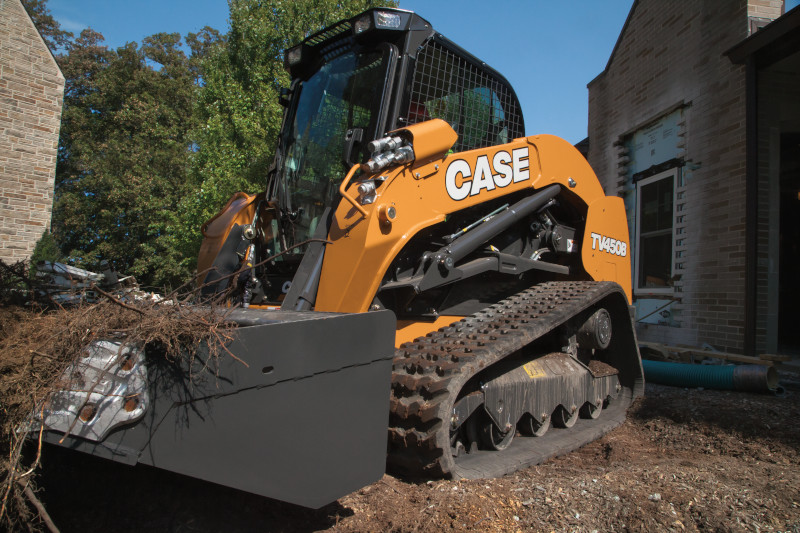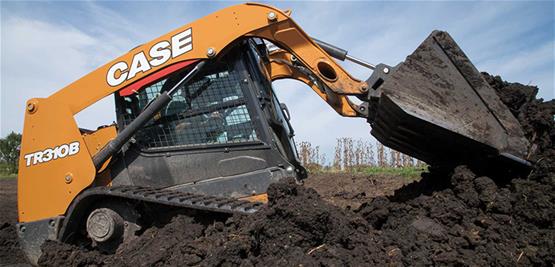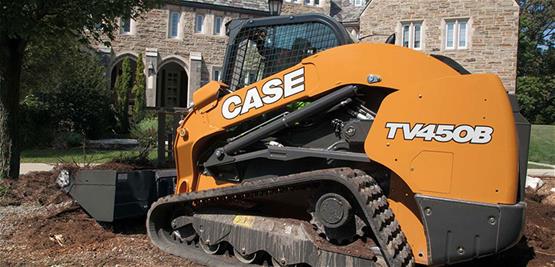
History of Skid Steers
The first skid steer was a three wheel model built by Cyril and Louis Keller in Rothsay, Minnesota in 1957. It was designed and built to help a friend clean the manure from his turkey barn, and it was able to operate in tight spaces while still getting the job done just as well as their large loader. In 1958, the Melroe brothers who owned Melroe Manufacturing Company in Gwinner, North Dakota, bought the rights to the loader and continued to perfect the

machine with the help of the Keller brothers. They soon developed the M-200 Melroe self-propelled loader with an 12.9 hp engine and a 750lb lift capacity. They continued to alter and produce better units, and after a few years they had developed the M440 Melroe Bobcat, which is widely considered the first true skid-steer loader. By 1969 the Keller brothers had built 10,000 skid loaders, and their 371 model was named "Mini-Bob" and retailed for $4,729.
Since then there have been many manufacturers who have put their own spin on the original Bobcat skid steer, including Case, John Deere, New Holland, Caterpillar, Kubota, and many others. Over the past 50 years many improvements have been made to increase the productivity, comfort, and safety of the skid steer loader.
Types of Skid Steers
Skid Steers can be classified a number of different ways: Lift, wheel/track, frame size, horsepower, controls, and amenities.
Lift: There are two main types of skid steer lift designs: radial and vertical. Each offers advantages and trade-offs in terms of performance, and each are more suited to some applications than others. Radial lift skid steers' bucket or attachment follows an arc as the loader arms are raised from ground level to maximum lift height. As an operator raises the lift arms on a radial lift skid steer, the edge of the bucket or forks will pull back closer to the front of the skid steer. Vertical lift skid steers use linkages in the lift arm mechanism to ensure that the bucket or attachment is same distance forward through the full arc of the lift cycle from ground level to maximum lift height. Vertical lift skid steers are ideal for lifting and placing loads. Oftentimes vertical lift skid steers will be equipped with a self-leveling mechanism that provides further productivity in lift-and-place applications. Radial lift skid steers have a simpler lift arm design (minus the linkage) and are ideally suited for digging, pushing, and other ground-level applications.
raises the lift arms on a radial lift skid steer, the edge of the bucket or forks will pull back closer to the front of the skid steer. Vertical lift skid steers use linkages in the lift arm mechanism to ensure that the bucket or attachment is same distance forward through the full arc of the lift cycle from ground level to maximum lift height. Vertical lift skid steers are ideal for lifting and placing loads. Oftentimes vertical lift skid steers will be equipped with a self-leveling mechanism that provides further productivity in lift-and-place applications. Radial lift skid steers have a simpler lift arm design (minus the linkage) and are ideally suited for digging, pushing, and other ground-level applications.
Wheel/track: For the first 40+ years, skid steers could only be purchased with wheels. At some point during that time over-the-tire track solutions were developed to convert wheeled skid steers to tracks in order to provide more floatation in difficult conditions. Today, full-time track models commonly referred to as Compact Track Loaders or CTLs, are the fastest growing segment in the skid steer market. While wheeled skid steers still have advantages including a lower initial cost, ability to operate on hard surfaces, and reduced operating weight, CTLs have found great popularity due to the floatation, traction, and stability provided by the tracks. While this comes with a higher initial price and higher operating costs (replacing tracks and undercarriage components is more expensive the replacing tires), many contractors find the trade-off more than worthwhile due to the extra productivity provided by CTLs in a variety of applications.
Frame Size: Skid steers differ in weight and height which affect their mobility and suitability for specific applications. Large frame models with 2,200+ pound minimum rated operating capacity and at least 70HP offer the HP and capacity to take on jobs where heavy loads are the norm and high productivity is required. Medium frames machines with 1,750-2,200 pound rated operating capacity with 60-70HP offer a more "all-around" machine with the capacity to take on most jobs and attachments while retaining a smaller footprint and lower price tag. Small frame skid steers <1,750 pound rated operating capacity and around <60HP are mostly used for farm chores or other non-construction applications.
Controls: Normally the biggest sticking point for experienced operators are between those that prefer to run all the controls through hand-operated joysticks ("hand controls") and those that prefer to use foot levers to control the boom and bucket functions on the skid steer ("foot controls"). Some manufactures offer packages that allow operators to choose either "hand" or "foot" on the same machine and swap between the two to cater to different operator's preferences. In general, hand controls have become more popular and most machines today use joysticks to control all functions of the skid steer electronically - referred to as "EH Controls" which is short for electronic hand controls.
Choosing the right skid steer for your application
Skid Steers are highly versatile machines which can be used in a wide variety of applications. Many operators use one skid steer in a variety of applications. When choosing one machine to do everything, consider what the majority of the work will be and choose the machine that best fits that application knowing that most skid steers can perform adequately in applications that they are not optimally designed for. An example would be a landscape contractor who does snow removal during the winter off-season. In this case, most of the work is landscaping which would favor a CTL. Although a track machine is not ideal for snow and ice, it's still able to perform adequately in the winter while being the optimal choice for the main application.
_91cf1d91-7b98-4fc0-b9d0-de06d81e47ac.jpg?sfvrsn=3cadebb1_1)
1. Site Development - Large Frame CTLs equipped with Radial Lift
Site development - rough grading, finish grading, etc. - means moving a lot of material around, which is something that the HP, capacity, traction, and stability of a large frame CTL is ideally suited for. And when it comes to doing grade work, nothing holds grade better than a CTL with stability that tracks over the roughest, most difficult ground conditions. CTLs provide plenty of floatation in soft or muddy conditions. Radial Lift models typically have higher HP-to-weight ratio, and the vertical linkage of a Vertical Lift machine is not needed for most site development applications.
2. Digging - Large Frame CTL equipped with Radial Lift
Larger, high HP CTLs have the weight, traction and HP to dig into the ground or stockpile of material and the lift capacity to carry and move material the most efficiently. The radial lift design provides more break-out force and faster cycle times than Vertical Lift models.
3. Material Handling - Large Frame Skid Steer or CTL equipped with Vertical Lift
Different surfaces offer competitive advantages to wheels or tracks. When working on hard surfaces such as concrete, asphalt, or gravel, skid steer tires offer better wear which results in lower operating costs than CTLs where tracks and the undercarriage_5c022a6b-9e9c-469c-a47f-88da303036fc.jpg?sfvrsn=6d2c37a2_1) take significantly more wear from operating on hard surfaces. Soft worksite conditions where mud or sand is a constant threat, or any uneven, difficult surfaces favor large frame CTLs which offer the floatation, stability and HP to power through soft spots while avoid tipping when carrying a load. A Vertical Lift is going to provide the best productivity for any material handling applications, as the linkage of the arm keeps the load further away from the machine allowing the operator better access to drop the load on the trailer or to dump closer to the center of the truck/trailer.
take significantly more wear from operating on hard surfaces. Soft worksite conditions where mud or sand is a constant threat, or any uneven, difficult surfaces favor large frame CTLs which offer the floatation, stability and HP to power through soft spots while avoid tipping when carrying a load. A Vertical Lift is going to provide the best productivity for any material handling applications, as the linkage of the arm keeps the load further away from the machine allowing the operator better access to drop the load on the trailer or to dump closer to the center of the truck/trailer.
4. Loading - Vertical Lift Models
The vertical linkage keeps the bucket, forks or other attachment farther from the front of the skid steer, making it easier for the operator to place the load on a truck or dump a load further towards the middle of the truck. In the Case line-up, all units with a "V" in their model name are Vertical Lift models (ex. SV340 or TV380).
5. Demolition and Clean Up - Radial or Vertical Lift CTLs
A CTL is usually the best choice for demolition given the tire hazards normally present on this type of jobsite. The optimal CTL configuration for demolition work will depend on the size of the project, the type/weight of the material and the tightness of the jobsite. If maneuverability is a key factor, a smaller frame CTL is probably ideal. If the material is heavy and/or the project is large, then a larger, high-HP CTL that maximizes lift capacity and pushing power would be preferable. In either case, a Vertical Lift CTL is the optimal choice if it's being used to load trucks directly. If the CTL is being used to push or pile debris on the jobsite, then a Radial Lift design would probably be a better fit.
6. Landscaping - Radial or Vertical Lift CTLs
Landscapers usually choose a CTL due to the floatation and ability to handle large loads such as transplanted trees or landscape materials like rocks, sod, boulders and dirt. Size is a trade-off in landscaping applications. Large frame CTLs offer maximum payloads and ability to move more material with less trips. However large, heavy machinery is not always a plus on landscape projects. Smaller CTLs offer advantages for soft ground conditions, or to get into tighter areas in existing yards with fences and trees present. Both radial and vertical lift skids perform well in landscape applications although Vertical Lift does offer advantages to landscape contractors that do a lot of sod or tree projects that involve frequent unloading of trucks and trailers.
Lastly, two of the biggest developments in the design of skid steers since the Kellers first developed the concept are safety and operator comfort. Today's skid steers offer a variety of safety features that were absent during the early development of the machines. These include ROPS structures which protect the operator from being crushed during a roll-over or from material falling onto the cab, safety switches which disengage the controls when an operator is not present in the seat, lap restraints which protect operators from being thrown into the door or out of the machine during operation, and even integrated back-up cameras which offer a high definition view of what's directly behind a machine while backing up. In addition to these and other safety features, today's machines are much more comfortable to operate for long hours. Features like climate controlled cabs, heated seats, low-effort EH or pilot hand controls, creeper speed options, hydraulic couplers, 2-speed travel motors, ride control, radio and many others reduce operator fatigue and make long days "at the office" more enjoyable.
crushed during a roll-over or from material falling onto the cab, safety switches which disengage the controls when an operator is not present in the seat, lap restraints which protect operators from being thrown into the door or out of the machine during operation, and even integrated back-up cameras which offer a high definition view of what's directly behind a machine while backing up. In addition to these and other safety features, today's machines are much more comfortable to operate for long hours. Features like climate controlled cabs, heated seats, low-effort EH or pilot hand controls, creeper speed options, hydraulic couplers, 2-speed travel motors, ride control, radio and many others reduce operator fatigue and make long days "at the office" more enjoyable.
Titan Machinery is a Case Construction and New Holland supplier of skid steers. We also offer many used skid steers and CTLs of various brands including Bobcat, Kubota, and Caterpillar. To see our new and used skid steers click the buttons below.
Used Skid Steers New Skid Steers